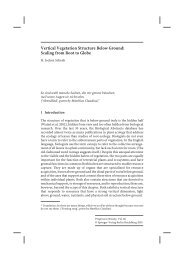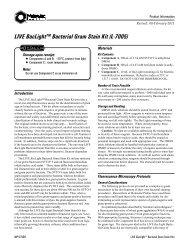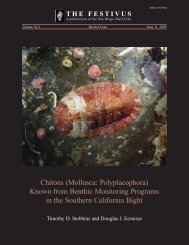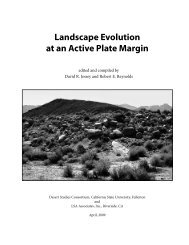2010 Overboard in the Mojave - Biological Science - California State ...
2010 Overboard in the Mojave - Biological Science - California State ...
2010 Overboard in the Mojave - Biological Science - California State ...
You also want an ePaper? Increase the reach of your titles
YUMPU automatically turns print PDFs into web optimized ePapers that Google loves.
To <strong>the</strong> north, <strong>the</strong> lower and upper parts of Member<br />
C are separated by <strong>the</strong> upper wedge of Member B. These<br />
two lacustr<strong>in</strong>e layers of Member C were attributed to<br />
two dist<strong>in</strong>ct lake phases by Buwalda (1914) and W<strong>in</strong>-<br />
george t. jefferson<br />
Table 1. Radiometric and absolute dates from Lake Manix Bas<strong>in</strong><br />
Age yr BP Location Material Method Laboratory Source/s<br />
11,810 + 100 Coyote Lake bas<strong>in</strong> Anodonta shell 14 C UCLA 2609C Meek, 1990<br />
12,900 + 120 Coyote Lake bas<strong>in</strong> Anodonta shell 14 C UCLA 2606 Meek, 1990<br />
13,560 + 145 Coyote Lake bas<strong>in</strong> Anodonta shell 14 C UCLA 2609B Meek, 1990<br />
13,800 + 600 Coyote Lake bas<strong>in</strong> Anodonta shell 14 C La Jolla 958 Hubbs et al., 1965<br />
14,230 + 1,325* Afton bas<strong>in</strong> Anodonta shell 14 C UCLA 2601 Meek, 1989, 1990<br />
15,025 + 230 Troy Lake bas<strong>in</strong> Anodonta shell 14 C UCLA 2605 Meek, 1990<br />
15,125 + 270 Coyote Lake bas<strong>in</strong> Anodonta shell 14 C UCLA 2608 Meek, 1990<br />
16,750 + 1,000 central Manix bas<strong>in</strong> oncoid stromatolite 14 C UCLA 1079 Berger and Libby, 1967<br />
17,950 + 1,500 Coyote Lake bas<strong>in</strong> Anodonta shell 14 C UCLA 6203 Meek, 1990<br />
18,150 + 400 Afton bas<strong>in</strong> Anodonta shell 14 C UCLA 2607 Meek, 1990<br />
19,100 + 250 Manix bas<strong>in</strong> D Anodonta shell 14 C QC 1467 R. Pardi, pers. comm., 1983; Jefferson, 1985a<br />
19,300 + 400 Afton bas<strong>in</strong> oncoid stromatolite 14 C UCLA 121 Fergusson and Libby, 1962<br />
19,500 + 500 Afton bas<strong>in</strong> oncoid stromatolite 14 C La Jolla 269 Hubbs et al., 1962<br />
19,700 + 260 central Manix bas<strong>in</strong> oncoid stromatolite 14 C UCLA 2600B Meek, 1990<br />
20,500 + ? Afton bas<strong>in</strong> Anodonta shell 14 C Yale Stuiver, 1969; Bassett and Jefferson, 1971<br />
20,980 + 345 central Manix bas<strong>in</strong> oncoid stromatolite 14 C UCLA 2602 Meek, 1990<br />
21,300 + 1,710 Afton bas<strong>in</strong> Anodonta shell 14 C — Meek, 1999<br />
23,090 + 445 central Manix bas<strong>in</strong> Anodonta shell 14 C UCLA 2600A Meek, 1990<br />
28,960 + 2,490 Afton bas<strong>in</strong> Anodonta shell 14 C UCLA 2601C Meek, 1999<br />
29,310 + 310 Afton bas<strong>in</strong> Anodonta shell 14 C CAMS 1856 Meek, 1999<br />
30,650 + 890 Afton bas<strong>in</strong> Anodonta shell 14 C UCLA 2604 Meek, 1990<br />
30,950 + 1,000 Afton bas<strong>in</strong> oncoid stromatolite 14 C La Jolla 895 Hubbs et al., 1965<br />
35 + (<strong>in</strong>f<strong>in</strong>ite) Manix bas<strong>in</strong> D Anodonta shell 14 C UCLA R. Berger, pers. comm., 1982; Jefferson, 1985a<br />
47 + (<strong>in</strong>f<strong>in</strong>ite)** Manix bas<strong>in</strong> D Anodonta shell 14 C Yale Stuiver, 1969; Bassett and Jefferson, 1971<br />
47,700 + 2.0 Manix bas<strong>in</strong> D Mammuthus bone U/Th USGS 81-48 J. Bischoff, pers. comm. 1982, 1983: Jefferson, 1985a<br />
51,200 + 2.5 Manix bas<strong>in</strong> D Hemiauchenia bone U/Th USGS 81-49 J. Bischoff, pers. comm. 1982, 1983: Jefferson, 1985a<br />
60,300 + ? Manix bas<strong>in</strong> D Mammalia bone U/Th USGS Bud<strong>in</strong>ger, 1992<br />
68,000 + 4.0 Manix bas<strong>in</strong> C Camelops bone U/Th USGS 81-51 J. Bischoff, pers. comm., 1982, 1983; Jefferson, 1985a<br />
74,000 + ? Manix bas<strong>in</strong> D Anodonta shell U/Th USGS Bud<strong>in</strong>ger, 1992<br />
80,000 + ? Afton bas<strong>in</strong> oncoid stromatolite U/Th — Meek, 2000<br />
183,800 + 12.0 Manix bas<strong>in</strong> C Camelops bone U/Th USGS 81-30 J. Bischoff, pers. comm., 1982, 1983; Jefferson, 1985a<br />
185,000 + 15.0 Manix bas<strong>in</strong> C tephra chemical — Bacon and Duffield, 1981; Izett, 1981<br />
350 + (<strong>in</strong>f<strong>in</strong>ite) Manix bas<strong>in</strong> B Equus bone U/Th USGS 80-51 J. Bischoff, pers. comm., 1982, 1983; Jefferson, 1985a<br />
Notes: Ages are uncorrected. Manix Formation Members (B through D) are designated where known. Meek (1990) provides corrected 14C ages for analyses from Manix bas<strong>in</strong> and<br />
a discussion of <strong>the</strong> reliability of both Anodonta and oncoid stromatolite tufa determ<strong>in</strong>ations.<br />
* This age has been revised, UCLA 2601C (Meek 1999). ** The previously reported age of 49 + ka for this sample (Jefferson, 1985a) is an error.<br />
Figure 9. Eroded exposures of <strong>the</strong> Manix Formation. The view is to <strong>the</strong><br />
east, from <strong>the</strong> north side of <strong>the</strong> <strong>Mojave</strong> River about 3 km east of Camp<br />
Cady. Light gray-green lacustr<strong>in</strong>e silts and clays, Member C, are present<br />
<strong>in</strong> <strong>the</strong> foreground and to <strong>the</strong> left of <strong>the</strong> image. Fanglomerates of Member<br />
A form a 7 to 8 m-high bluff <strong>in</strong> <strong>the</strong> right mid-image. The <strong>Mojave</strong> River is<br />
to <strong>the</strong> right, and <strong>the</strong> Cady Mounta<strong>in</strong>s appear on <strong>the</strong> horizon.<br />
ters (1954). The two layers are well exposed to <strong>the</strong> east<br />
throughout <strong>the</strong> Afton bas<strong>in</strong> (Ellsworth, 1933; Blackwelder<br />
and Ellsworth, 1936). In eastern Afton bas<strong>in</strong>, Member<br />
C <strong>in</strong>terf<strong>in</strong>gers with, and is locally overla<strong>in</strong> by alluvial fan<br />
deposits shed to <strong>the</strong> north from <strong>the</strong> eastern<br />
Cady Mounta<strong>in</strong>s (Blackwelder and Ellsworth,<br />
1936; Meek, 2000).<br />
A 0.5–1 m-thick pale yellowish-orange to<br />
grayish-orange, poorly bedded, moderately<br />
to well sorted, subrounded, medium-gra<strong>in</strong>ed,<br />
quartz-rich arkose is commonly present<br />
where <strong>the</strong> base of lower Member C laps onto<br />
Member A and overlies <strong>the</strong> lower wedge of<br />
Member B. The arkose rests on light gray,<br />
rugose oncoids that have grown on clasts at<br />
<strong>the</strong> top of Members A and B (Fig. 8). Much<br />
of <strong>the</strong> avian and terrestrial vertebrate assemblage<br />
has been recovered from this timetransgressive<br />
littoral horizon.<br />
Three th<strong>in</strong> (0.1–0.15 m-thick), laterally<br />
persistent, grayish-orange, moderately well<br />
bedded, moderately well sorted, subrounded,<br />
medium-gra<strong>in</strong>ed, quartz-rich arkose beds are<br />
present <strong>in</strong> <strong>the</strong> middle-upper part of Member<br />
C. These sandy horizons, like those at<br />
44 <strong>2010</strong> Desert Symposium
















